My first night in Sapa, in November of 1998, I went walking alone down the main street. I was looking for evidence of prostitution among the young Hmong girls that spend their days and nights hanging out with tourists. It didn’t take me long to get an offer.
Just after midnight, I bundled up to guard against the chill and left my guesthouse room. I scrunched my shoulders up and shoved my hands into my pockets. There was a cold, wet mist in the air, which gave an ethereal glow to the weak tungsten street lamps and house lights that led up the road toward the market. A huge structure in dull gray cement, the two buildings of the Sapa market sit dominant at the top of the main street, which then drops down past a series of shops and guesthouses before leading out of town and into the valley.
I walked into the dark shadows between the two buildings and up the stairs to the main street. Everything had shut down. There were no lights on and the road was completely deserted. Down I went, in the direction of the bar on the outskirts of town. I walked slowly, and as I came to a slight bend in the road, a few figures emerged from the darkness. A young Hmong woman was walking right toward me. She was almost invisible in her dark, indigo-blue clothing. As I reached her I slowed even more, almost to a standstill.
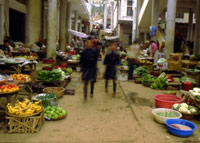
“Hello,” she said, with a weak smile, stopping as well to stand there next to me. I turned around and we took a few steps together back up the street. I was about to ask her name, when a man suddenly appeared heading toward us. He was an older guy, and as he passed he said something to the girl in very quick Vietnamese, which I didn’t catch. We continued walking, but within seconds another Vietnamese man, this time younger, appeared at my side.
“You want drugs?” he asked in Vietnamese. “Opium? Girls?”
I brushed him off tersely and quickened my pace a bit. The girl stopped walking, and I left her behind. I continued up the street, but soon slowed my pace again. I could hear the girl following behind me. I continued all the way back up to the stairs leading down to the market. I stopped there and looked back at the girl, who had moved over a bit and was walking in the middle of the road. She kept her pace slow and looked at me as she went past.
“Okay,” she said quietly, motioning with her head for me to follow. I turned my back on her and walked down the stairs, being careful not to slip on the smooth, damp stones. I felt rather silly, as I was not accustomed to propositioning young women. I wasn’t sure of the girl’s age, but she was definitely a few years older than most of the kids that run around the streets of Sapa all day. She may have been as young as 16, but more likely was 18 or 19. Since Hmong women marry as young as 13, this girl probably had children of her own.
***
The train wound its way north all night, and by the time light appeared in the window we were well into the hills, only an hour outside Lao Cai city, the province capital. We arrived at around 7:00 am, and from the train station we walked across the street, still groggy from the sleepless night, and boarded a minibus that took us west, up a road that twisted skyward into the clouds. I knew this road was once a pot-holed, broken path that took hours to ascend. Now, tourist dollars had allowed the district to pave the whole distance, and the journey took a mere 90 minutes. It was a clear day – rare in Sapa – so we were welcomed first by the steep hills and their rows of high, terraced rice fields.
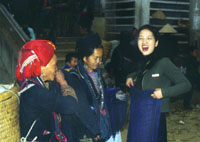
I had come to Sapa, a resort town high in the mountains, to write a story about the impact of tourism on the Hmong community, particularly young girls. Friends in Hanoi told me about what seemed a dire situation, and I thought it would be a good way to finally do some research and writing on the changes sweeping Vietnam. My work at the newspaper kept me stuck in Hanoi for several months, but when the chance came I took a Friday off work, so I could leave for Sapa on the Thursday night train.
After arriving in Sapa, high atop a stunning valley, we were greeted by two groups of people: the Vietnamese owners of guesthouses, jostling for customers; and a ragtag group of young Hmong girls, looking to make ‘friends’ – their term for the tourists who buy their trinkets, listen to their stories, and maybe visit their villages. We cut through the crowd and emerged with a Hmong girl standing by our side.
“Where you go?” she asked in English. I told her the guesthouse we were aiming for, and she offered to take us there. “My name Mi. What your name?” she asked. I said ‘Mai’ and she laughed at me – “That’s a girl name!” When I spoke a few words of Vietnamese to her, she looked horrified. “No speak Vietnamee!” she commanded me. “Why you speak Vietnamee? I hate Vietnamee!”
“Okay okay,” I said, backing down from this challenge. I told her I worked in Hanoi and had lived in Vietnam for two years already. “You know Steve and Liz?” I asked, assuming Sapa was small enough that all the Hmong girls would know my British friends, who had been to the town several times.
“Sure! They my friend. You know Stee and Leez too?”
When I told her they were my close friends, she looked me over in this new light. “Leez and Stee-van velly good,” she said, nodding with approval.
We walked through the market and down the road leading toward Cat Cat village. The guesthouse was one of the last buildings on the right, with a sweeping view of the valley below. My friend and I found a room on the second floor, then went down for breakfast on the terrace overlooking the street. Mi was still outside on the street. “Hey Mai!” she shouted, waving me over. I went down to chat for a while, and when I returned to the terrace my friend was swarmed by two ancient Hmong women, trying to sell her clothes and fabric. They had draped a hat on her head and thrown a shirt over her back. “You buy okay? Jolie jolie!” We tried to fend them off but they continued their pidgin sales pitch. “You buy okay? Mama Sapa no money.”
When I didn’t seem interested in the clothes, one of the women tucked a hand into her tunic and brought out a small bag of marijuana. “Okay you buy?” she asked, with a big smile and a wink. Eventually the guesthouse owner came out and shooed the old women away, leaving us to laugh over our coffees at the Mama-Sapa-no-money. More young girls had now walked down the hill to get a look at us, conferring with Mi – who was now sticking her tongue out whenever I looked over. We finished breakfast and I shouldered my camera bag and headed up toward the market. Sapa sure was a funny place.
***
The Hmong, numbering around 700,000 in Vietnam, are one of Southeast Asia’s largest and widest-spread highland cultures. From their ancestral homeland in southern China, the Hmong over hundreds of years have moved further south into Vietnam, Lao, Thailand, and Burma. Highland communities like the Hmong have intrigued travelers for generations, and trekking tours have been a top draw in neighboring Thailand for many years. The town of Sapa is the center of a mountain district of 40,000 people, over half of whom are Hmong, followed by Dao, Vietnamese, and a small number of Giay. The Giay and Dao (pronounced ‘Zao’) are also highland minority groups, who like the Hmong have languages and cultures very different from the Vietnamese majority living in the lowlands.
French colonialists built Sapa in the 1920s as a resort, and after 70 years of revolution and war, it returned to its roots. Tourists again began to make the arduous journey to Sapa in the early 1990s, and in less than ten years the small market town boomed into a major draw for travelers. For Vietnamese from the lowlands, the main attraction is the cool weather and scenery. Westerners, mainly backpackers, are drawn to the minority people themselves – particularly the children. The girls who greet tourists as they step off minibuses are an immediate hit. Ranging in age from seven to 15 years, they speak adorable pidgin English, and the older girls speak some French and a few words of Japanese and Chinese. All but the youngest have lost the shy nature of village children. They tease each other and joke around with foreigners at first meeting. They hold hands and hug female travelers. And while slightly more reticent with men, the girls still shake hands and flash big, gold-toothed grins.
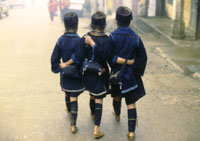
This brash confidence and skill with languages is evidence of the range of influences on their young lives. While tourists expect to discover traditional, indigenous peoples, as visitors staying only a few days they seldom consider the strong impact of their own culture. The carefree life of travelers, however, is a far cry from growing up in a poor village. As the girls learned to enjoy the freedom tourists have, they were pulled farther away from their families. In town, the girls were surrounded by people who look down on them – older Hmong, other minority groups, and the Vietnamese – and this only made them more confused and isolated from their community. Some all but abandoned their villages, and on the cold, cloudy streets of Sapa they fell victim to abuse from foreigners and Vietnamese alike. No supervision led to late nights of drinking and partying with tourists – and this led to sexual abuse and even prostitution.
The Vietnamese locals were generally not concerned with this plight. Many viewed the girls as obnoxious and unruly, necessary only to attract tourist dollars. The authorities also appeared ambivalent, concerned with the spread of ‘social evils,’ but unwilling to take steps that might damage Sapa’s tourism-based economy. Rapid economic growth had a huge impact on the lives of people in Sapa town, and even the surrounding district. But the benefits of tourism were not equally distributed, as the Hmong and other minorities had no capital to take advantage of new opportunities. Furthermore, they had almost no say in how tourism developed. As a result, the Hmong – who were little prepared for tourism – were not able to solve the problems that appeared. Families initially liked the extra income their daughters brought back from town, but they did not foresee other consequences.
But even those who have studied the situation in Sapa are not entirely certain what the Hmong think about their young girls. Hmong society is very unforgiving to young women who break social rules, and at least one of the girls was banished from her village after being accused of sleeping with a foreigner. While individual parents may be very hurt by what has happened to their daughters, these feelings are not expressed outside the family or village. After generations of being looked down upon by the majority Vietnamese, the Hmong – while very friendly – often remain quiet about the dealings of their own community.
***
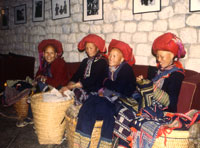
The girl I hung out with the most my first few trips to Sapa was Sa, a skinny nine-year-old with an infectious, hyperactive laugh. She seemed to spend more time wandering around by herself then most of the other girls, who generally patrolled the streets in groups of two or three. On one damp, drizzly afternoon she ran into me outside my guesthouse, and I took a bunch of photos of her making faces at my camera. She would twist her face up for a few seconds, and then dissolve in laughter as I tried to focus my lens. Pretty soon we were both laughing hysterically, which made for some decent photos. The next time I went up to Sapa, I gave her a few of the pictures, and she nodded with approval before slipping them into her bag, next to the dozens of other photos tourists had given her. Sa spoke English quite well, and when I started work at the NGO she amazed one of my Hmong colleagues by chatting away with me in a language he found impossibly difficult. When my mother came to visit in May 1999, we went up to Sapa for a weekend, and ended up spending a day with Sa. She took us to her family house, in Lau Chai village down in the valley. On the way there, we talked a bit about her family, but most of our banter was throwing insults back and forth. “You a donkey!” Sa would say, scrunching up her face in laughter. “Sa, you’re crazy,” I would respond, shaking my head. Any time she perceived the slightest affront, she would walk off in mock disgust, “We no friend. Bye-bye, I see you never!”
When we reached her house, she helped her father cook a simple meal of rice and beans. We had bought some vegetables and noodles at the market, and she left these in a cupboard. After the meal, we made to leave, and Sa’s father asked us for some money. I gave him a small amount, which he didn’t seem too pleased with. But Sa didn’t intervene, and together we made the walk back up to Sapa, leaving her gang of smaller brothers and sisters at the house. Sa also had an older sister, Zhi, who rarely came back to the village. She stayed mainly in Sapa, where she got up to no good. Zhi was among the first group of girls that learned English and stayed in Sapa, and I figured in a year or so her little sister Sa would follow in these dubious footsteps. I had heard a lot of stories about the girls, and one rumor had it that Sa had already been abused by a tourist. Nothing we could confirm though, just another Sapa story.
***
There has been a market in Sapa for many generations. Before the French built Sapa town, the local population gathered at a regular market along the banks of a river that flows down to the valley below. After the town was built, the market moved to its current, urban location. Young girls have always accompanied their mothers into town for the weekend market, where women trade handicrafts and agricultural produce, as well as gossip and exchange news of distant communities. People from even the most remote parts of the district come to Sapa at least once a month, some walking for two days. When tourists began to arrive in the early 1990s, some Hmong women started selling handicrafts, mainly clothing and small items of jewelry like bracelets. The women noticed that the tourists were enamored with young babies and girls – who were then used as bait to make more sales. The young daughters were initially very shy, but this changed when the girls received from tourists two things they were not accustomed to: emotional attention, and money.
Village life sees young girls handed hard work and responsibility from a very young age. As soon as babies are past the nursing stage of one or two years, they are handed to older siblings, who care for them while their mothers are working in the fields. In families with as many as ten or more children, this leaves young girls with a lot of work and little time for love and affection from parents. In contrast, Dao families are smaller and better off – and even Hmong women agree that Dao mothers and daughters have closer relationships.
In Sapa, Hmong girls found tourists who were only too willing to lather them with attention, and even better, buy things for them or give them a little money. At this point, the girls realized they could have more fun, do no work, and make lots of money, by staying in town full time. As one American who worked in Sapa said: “The girls got swept up in the pizzazz of foreign life; the freedom of jumping on the back of a motorbike, or being invited out for drinks – the carnival of being around tourists.”
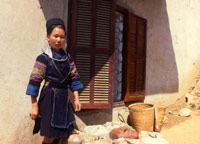
Now able to care for themselves with their earnings, the girls ignored their mothers’ pleas to return home. In some cases, parents may have been in favor of their daughters staying in Sapa, as long as they brought money back home. As the girls began to stay in town more often, they made their own rules and followed a pattern of behavior completely foreign to their former lives.
The average day for a youngster like Mi or one of her friends begins at five or six in the morning, when they rise and go to the market for breakfast. They sleep together in a small shack below a Vietnamese household at one end of the main street, paying a small nightly fee of 1,000 dong (less than 10 cents). After breakfast, it’s up to the main road, where by 8:00 or 8:30 am, minibuses arrive bearing tourists from Lao Cai. Immediately, the girls swarm the bewildered travelers and begin to chat them up, finding out their names and countries, and where they will be staying. The girls divide up the tourists amongst themselves – with occasional arguments breaking out over ‘whose tourist is whose.’ To stake their claim, the girls often give colorful wristbands to their newly-arrived friends. Thankful for such a nice present, most tourists seem unaware that they have been tagged as property.
From here, the girls will accompany the tourists to their guesthouses, often waiting outside while they check in. Later, they will show their new friends around town, and try to sell them small handicraft items like bracelets and mouth organs. Occasionally, they will lead the tourists back to their villages, where families ask the visitors for money. Tourists grow very attached to the young girls, very quickly. Mi and her friends play emotional games that have become so routine that they repeat the same phrases over and over again, for a new audience each time.
“You my special friend,” Mi says to tourist after tourist. “You go away I very-very sad. You promise you write letter? I think you no write letter. Maybe you no my friend….”
With this, the concerned tourist pours yet more attention on the young girl, and, if all goes according to plan, a little money as well. “You promised me you buy something!” one girl cried to a stunned tourist, who made no such promise but felt obliged to hand over money anyway. Once this pattern has been witnessed several times, it is easy to believe the girls are just performers who – like professional actors – can pass from happiness to anger as often as they want, with no impact on their psyche. But a close look reveals they are still confused children.
All the girls carry small bags that trace the history of their involvement with tourists. They each have dozens of photographs, postcards and letters – some dating back years – sent to them from around the world. Although illiterate, their memory of faces and nationalities is astounding. They ask tourists to do the reading and writing for them, and it is this last activity that best exposes their fragile nature. One 14-year-old asked me to dictate the following letter for a friend in Belgium:
“I hope you come see me again. You no come see me maybe I die. Before you come here and I don’t forget you. You and me very special friends. Do you remember me? Before you give me 200,000 dong (about US$14)…. Maybe now you married. You bring wife come see me? You say three years maybe you come see me.”
While repeating what now amount to form letters, the mood of the girls is often sullen, occasionally to the point of tears. If this is acting for the benefit of tourists, it is quite a performance. More likely, the girls themselves have lost track of their emotions. They try to blackmail people for money and attention, but this pastime has become so frequent, repeated so often, that the girls have forgotten it’s a game.
It is not only their young minds that are vulnerable. On the streets late at night, or sitting in bars with groups of foreigners, the girls are exposed to situations they cannot control. Some of the girls sing and play music at a bar on the outskirts of town, where they are surrounded by foreigners. A few are known to have taken money for sex. The owner of one popular guesthouse said the problem boils down to a simple lack of supervision.
“The People’s Committee has said that no children are allowed on the streets at night, but this is hard (to enforce) because the girls want to stay and make money, and their villages are far away. There is no one here to tell them right and wrong, and that’s why they do things they don’t understand,” she said. While no one knew how common sexual abuse and prostitution had become, these problems were more than just rumors. The guesthouse owner said she knew several girls who had slept with foreigners for money, and she thought prostitution would continue unless someone stepped in to solve the problem.
***
There was now open talk among the Hmong of prostitution by some of the girls. It was the height of the summer tourist season, and the villages surrounding Sapa were flooded with visitors. Some of the Westerners in town began to comment on the behavior of two fellow tourists. A Belgian named Jan and a Swiss man named Berner – both in their mid-30s – were ‘dating’ two 12-year old girls named Pa and Zhi. Jan and Pa were caught in bed together on several occasions, at the house of a Vietnamese woman who rented out space to all the girls when they were in town. After watching Jan and Berner interact with the girls, someone became so suspicious they followed the two European men when they went for a walk one day with Pa, Zhi and a younger girl named Ju. They climbed a hill outside of town, looking for a private spot. Jan and Pa apparently had a stormy relationship, and Pa decided to make Jan jealous by walking off with a Hmong boy who happened to pass by. Jan broke into a fit, yelling and screaming as he ran back down the hill and into town (He was later heard to say, “That’s it, I’m out of town tomorrow, I can’t stand a 12-year-old Hmong girl fucking with my emotions”).
This left Berner, Zhi and the young Ju, who acted as a lookout while Berner and Zhi had sex. Watching from a distance, the someone who had followed them was most shocked by how willing and happy Zhi seemed with the proceedings.
The someone never confronted Zhi about this situation, because she didn’t want to lose the trust of the girls by admitting she had spied on them. The younger girl, Ju, was very upset by what had happened, however, and the next day she was heard crying, “I told her not to do it!” Berner was asked what was going on, but of course he denied any relationship. Others had seen how Jan and Berner were acting, however, and Jan disappeared after the police told him to get out of town. A group of tourists got hold of Berner, and one man apparently threw him against a wall and threatened severe bodily harm if Berner didn’t leave the girls alone. Berner was told he had been seen on the hill with Zhi and the police had been warned, so it might be best if he left Sapa. After Berner left, someone gave his and Jan’s names to their embassies and a child rights organization called ECPAT. Neither ever returned to Sapa, although Jan called from Belgium on several occasions. Since Pa spoke a bit of French, they could chat on the phone without the guesthouse owner understanding.
Jan was obviously troubled, with numerous psychological problems. Berner on the other hand was a teacher, very clean cut and polite, who talked often of wanting the help the girls. As it turns out, the girl he was with, Zhi, had already been with other foreign men, and she had been thrown out of the Sapa boarding school for fooling around with boys. A year or so after her adventure with Berner, Zhi and another girl came to Hanoi in the company of two Australian tour guides. The Aussies, who lived in Hanoi, drove the girls down in their jeep. It’s a twelve-hour drive, and the girls got away by telling their mothers they were going to Bac Ha for the day. Apparently it did not dawn on the Australians that – by the strict letter of the law – they were kidnapping two children. Zhi at one point phoned one of my old roommates and showed up at his new house for an impromptu visit. It didn’t take long before everyone knew the girls were in town – they may have changed out of their indigo hemp clothing, but their huge hoop earrings were a dead giveaway.
***
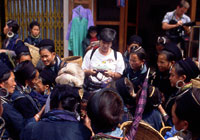
However bad things seem in Sapa, Vietnam is not Thailand or Cambodia. While prostitution is rampant in the cities, there are no streets lined with brothels full of children. Nevertheless, child prostitution has surfaced across the country, particularly in beach resorts like Nha Trang and Hoi An. International child welfare organizations initially ran into denial or disinterest when they talked about child sexual abuse with Vietnamese authorities, but attitudes began to change in the late 1990s. In 1996, several high-ranking officials attended a Stockholm conference on child sex abuse, after which several ministers were brought to a brothel in Cambodia where most of the prostitutes were Vietnamese children.
But whatever approach the government takes to child prostitution, the underlying problem, as in other countries, is poverty. Vietnam is poorer than many other countries in the region, and the highlands are the poorest areas of all. There is no question that poverty exacerbates the problems of the Hmong community in Sapa. Life is different for the Hmong in Thailand, who have been much less effected by tourism and prostitution than neighboring highland groups like the Akha and Lahu. On one of my trips to Sapa in 1998, I met a Hmong researcher from Thailand who was attending a workshop on tourism. “There is no situation like this among the Hmong in Thailand,” he said. “There, the Hmong community is wealthier, and has enough to eat… people don’t get involved in tourism, because it’s only a little bit of money.”
In Sapa, the Dao neighbors of the Hmong were slightly wealthier, and they responded to tourism in a different manner. At first, Dao women kept their children from interacting with tourists. The Dao live further away from town, which made contact with tourists less frequent. But more importantly, Dao women have a different position in their society than Hmong women. They have extensive knowledge of herbal medicine, allowing them to act as community healers. This strong role results in greater social freedom and independence – some say women can even have extramarital affairs with no social sanction. More Dao girls go to school, while the Hmong let their daughters run free to a much greater extent. While the Dao call this neglect, such a harsh judgment comes from long-held prejudices. After all, young people in many countries would find such freedom liberating. The problem was that, in Sapa, the freedom given to Hmong girls ended up pulling them away from their culture, towards a new identity they had no ability to shape.
***
With no help for the girls, and with ever more tourists arriving in Sapa, things should have been even more dire. But by 2001, the situation seemed to have changed for the better. No one is really sure why, but the older girls started to go back to their villages and get married, and continue with their lives as if nothing had happened. Despite the odds, the culture seemed to be winning out. I talked to one Vietnamese researcher who was convinced the girls were nothing more than precocious pre-teens, rebelling for a few years before settling down to motherhood at the ripe old age of 15 or so. She said the girls still support their families, and one girl even paid for the renovation of her parent’s house with the money she had made in Sapa. Others often paid for their family’s medical bills. While the researcher did not deny that sexual abuse was a threat, she felt the community was strong enough to deter this trend from continuing. Even the first wave, problem girls like Zhi, had mostly gone back to their villages.
The nature of tourism was starting to change, and backpackers were beginning to look elsewhere. Sapa was now seen as too spoiled by tourism, or simply too crowded, for those who wanted the experience of interacting with highland, ethnic minority cultures. Many people now went to Bac Ha, to the east of Sapa, or even further to places like Muong Khuong. Tour operators and guide books began promoting these places as ‘more traditional’ locations. In Sapa, the district authorities were concentrating on upscale hotels, and more hotels for Vietnamese tourists. The Vietnamese, who come to Sapa mainly for the scenery and cool weather, do not interact much with the Hmong and other minorities. The most pressing problems in Sapa now are environmental, rather than social. A path is being carved through the forested slopes of Fansipan mountain, for example, so Vietnamese tourists will be able to climb the peak. The forest, already void of animals from overhunting, will only suffer more as a result. Some of the Hmong girls, now fluent in Vietnamese and their unique pidgin English, will no doubt lead tours up the mountain. Whether they’re better off from tourism, in the end, is a difficult question to answer.
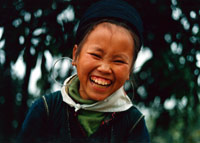
One of the last times I went to Sapa was in March 2001, when my parents came to visit me. We rented a jeep and drove to Sapa and Bac Ha. My mother had already been to Sapa, in 1999, so she knew Sa and some of the other girls. On an unusually bright, sunny day, we walked to Lau Chai village, down the valley about an hour’s walk from Sapa. Leaving the main road, Sa’s house was the first we passed. The former problem-child Zhi was outside, playing with some of her little sisters. She had been married for almost a year, and she had a little baby strapped to her back. I had not seen Zhi in a while, so I stopped to chat.
“This your baby?” I asked.
She smiled and said yes. I asked her if she went up to Sapa much any more.
“Not so much. Now mostly at home.”
Zhi seemed in good spirits, so I started joking with her in the pidgin English she had helped invent. “I see your sister in Sapa. She’s really crazy. Who’s more crazy, you or Sa?”
Zhi thought about this for a minute, before admitting that she was crazier than her sister. We laughed together at her honesty. We shook hands, and I made off to join my parents. “Okay Zhi,” I said, “Maybe see you never!”
I had the address written on a piece of paper. 79 Ly Thuong Kiet Street.
A visit from a man who claimed he was robbed at gunpoint and his secret documents stolen.
Richard Pettit was the Charles Bukowski of Hanoi in the late 1990s. This is one of his stories.
© 2017 Michael L. Gray. All Rights Reserved. Terms of Use | Privacy Policy